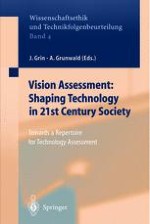One way to shape technology and its embedding in society in the 21st century is through the visions that guide their development, especially concerning the long-term societal perspective. A critical discussion and assessment of these visions is a prerequisite for influencing the course of development. Technology assessment, therefore, has to provide a methodological repertoire for assessing and constructing visions, taking into account the requirements for long-term orientation as well as the need for public legitimation. This volume draws upon insights from technology assessment, political sciences, epistemology, sociology and ethics. It is to contribute to the recent literature in on "shaping technology", taking into account the "co-evolution of technology and society". It connects to that technology assessment literature that emphasises TA's pro-active role and its contribution to political judgement.
